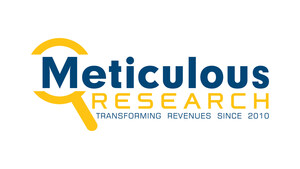Market Growth Driven by Rising Corporate ESG Commitments, Government Regulations, and Consumer Demand for Environmentally Responsible Products
REDDING, Calif., April 10, 2025 /PRNewswire/ -- According to a new market research report titled "Biodiversity and Natural Capital Credit Market by Type (Biodiversity Credits {Habitat Conservation, Restoration}, Natural Capital Credits {Carbon Sequestration}, Hybrid/Bundled Credits), and Geography - Global Forecast to 2032", published by Meticulous Research®, the global biodiversity and natural capital credit market is projected to reach $37.55 billion by 2032, growing at a robust CAGR of 26.1% from 2025 to 2032. This expansion is driven by the increasing recognition of the importance of biodiversity preservation and the growing demand for carbon-neutral and environmentally sustainable products.
Browse in-depth scope of Biodiversity and Natural Capital Credit Market Report:
109 – Tables
23 – Figures
130 – Pages
For more comprehensive insights, download the FREE report sample:
https://www.meticulousresearch.com/download-sample-report/cp_id=6154
KEY MARKET DRIVERS AND TRENDS
The market is experiencing rapid growth due to increasing corporate commitments to environmental, social, and governance (ESG) goals, particularly those focused on biodiversity and ecosystem protection. Government policies and international frameworks like the Kunming-Montreal Global Biodiversity Framework are also encouraging the development of biodiversity and natural capital credit markets. Additionally, advancements in technology, such as AI, remote sensing, and blockchain, are improving the transparency and verification of biodiversity credits.
GROWTH OPPORTUNITIES
There are substantial opportunities in the integration of carbon markets with biodiversity and natural capital credits, the expansion into marine and freshwater ecosystems, and the development of biodiversity-linked financial instruments. The increasing application of technology for biodiversity monitoring and verification is also expected to enhance market growth.
There is a significant opportunity to integrate biodiversity credits with carbon offset markets. As both biodiversity and carbon sequestration efforts contribute to environmental protection, the bundling of these credits can enhance the market's reach and appeal. This creates a more unified, comprehensive environmental credit market.
Furthermore, much of the focus has been on terrestrial ecosystems, there is growing recognition of the importance of marine and freshwater environments in maintaining global biodiversity. The expansion of credit markets into these ecosystems provides a vast untapped opportunity for growth.
As the market matures, the development of financial products tied to biodiversity credits, such as bonds or funds, can open up new investment channels. These products could attract a broader investor base, including institutional investors and hedge funds.
Additionally, technologies such as satellite imaging, AI-based monitoring systems, and blockchain can streamline the process of tracking and verifying biodiversity credits. These advancements are expected to reduce the cost and increase the transparency of credit certification processes, leading to greater market confidence and participation.
Get Insightful Data on Regions, Market Segments, Customer Landscape, and Top Companies (Charts, Tables, Figures and More)- https://www.meticulousresearch.com/product/biodiversity-and-natural-capital-credit-market-6154
MARKET CHALLENGES
Despite strong growth, the market faces challenges such as the lack of standardized measurement methodologies, high transaction costs, and concerns regarding the long-term effectiveness of conservation projects. Fragmented regulations and verification challenges could impede market progress.
One of the most pressing issues is the lack of consistent and standardized methodologies for measuring biodiversity outcomes. Without a universal framework for assessing biodiversity impacts, the market can face difficulties in ensuring the reliability and effectiveness of credits.
Furthermore, the process of acquiring and trading biodiversity and natural capital credits can be complex and costly. High transaction fees, combined with the need for expert verification and monitoring, can deter smaller companies from participating in the market. Reducing these costs will be critical to increasing market adoption.
SEGMENT INSIGHTS
The global biodiversity and natural capital credit market is segmented by credit type (biodiversity credits {habitat/ecosystem conservation credits, species conservation credits, restoration credits, avoided loss credits}, natural capital credits {carbon sequestration, watershed services, soil quality improvement, and pollination services} and hybrid/bundled credits {combined carbon and biodiversity credits, ecosystem service packages, and landscape-level conservation credits) and geography. The study also evaluates industry competitors and analyzes the market at the country and regional levels.
Market by Credit Type
By 2025, biodiversity credits are anticipated to lead the biodiversity and natural capital credit market landscape. This dominance is driven by several factors, including the growing awareness of the importance of preserving ecosystems and mitigating the effects of climate change and human activities on biodiversity. Furthermore, the increasing investments from both governmental and private sectors in safeguarding natural habitats. As regulatory frameworks across various regions become more aligned with biodiversity conservation objectives, there is a growing push to integrate these credits into corporate sustainability strategies. Companies are increasingly adopting biodiversity credits as part of their environmental responsibility efforts, recognizing the need to balance business growth with environmental stewardship. Global initiatives like the Convention on Biological Diversity (CBD) have further emphasized the importance of ecosystem conservation, making biodiversity credits a critical component of international conservation agendas.
On the other hand, the hybrid/bundled credits segment is expected to experience the highest growth rate during the forecast period, reflecting the increasing recognition that comprehensive, ecosystem-based solutions can simultaneously address climate change and biodiversity loss. These hybrid credits allow businesses, governments, and other stakeholders to purchase a single credit that covers multiple environmental aspects, providing a more integrated and effective approach to sustainability. The demand for bundled credits is growing as they offer a streamlined solution for organizations looking to meet diverse environmental goals, such as carbon emission reductions and biodiversity protection. The ability to bundle different types of credits appeals to a wide variety of participants, including corporations that want to adopt a more holistic sustainability strategy and governments implementing cross-sector environmental policies.
The rise of collaborative efforts between environmental organizations, businesses, and governments is further fueling the growth of hybrid credits. These partnerships are accelerating the development and adoption of bundled credits, driving the transition towards more integrated ecosystem service management. As the global focus shifts to broader environmental impact solutions, hybrid and bundled credits are set to become key drivers in achieving the shared goals of biodiversity conservation and climate change mitigation, making them an essential tool for a more sustainable future.
Request a customized research analysis tailored to your specific requirements: https://www.meticulousresearch.com/request-customization/cp_id=6154
GEOGRAPHIC MARKET INSIGHTS
Regionally, Europe is expected to lead the market by 2025, supported by its robust environmental regulations and growing corporate sustainability efforts. The European Union's stringent environmental policies and commitment to biodiversity preservation are driving the adoption of biodiversity credits among companies. Moreover, European countries are actively working toward meeting international biodiversity protection goals, encouraging further market growth.
Furthermore, the increasing collaboration between governments, corporations, and environmental organizations across these regions will further fuel the growth of the biodiversity and natural capital credit market. In Europe, the emphasis on achieving carbon neutrality and integrating nature-based solutions into climate strategies has created a favorable environment for biodiversity credit adoption. Initiatives like the European Green Deal and the EU Biodiversity Strategy for 2030 are playing a pivotal role in fostering this market growth, encouraging businesses to align their operations with sustainability goals.
In addition, North America and Asia-Pacific are anticipated to show strong growth in the coming years. North America's significant corporate investments in ESG initiatives and government policies targeting biodiversity protection will support market expansion. In North America, while the U.S. is leading in corporate investments in Environmental, Social, and Governance (ESG) initiatives, Canada is also taking proactive steps to preserve its vast natural resources. This includes the introduction of policies that incentivize biodiversity conservation and the reduction of environmental impacts.
Meanwhile, Asia-Pacific, driven by rapidly growing economies like China, India, and Japan, is expected to see a surge in demand for biodiversity and natural capital credits as governments in these regions implement more environmentally focused policies. These rapidly growing economies are seeing the rise of corporate responsibility and the integration of sustainability into business models, which is driving demand for biodiversity and natural capital credits. Governments in these regions are progressively adopting more stringent environmental policies, focusing on sustainable development, and integrating biodiversity protection into their national development plans. As a result, there is a growing recognition of the need to balance economic growth with environmental preservation.
Immediate Delivery Available | Buy this Research Report (Insights, Charts, Tables, Figures and More)- https://www.meticulousresearch.com/view-pricing/1471
COMPETITIVE LANDSCAPE
Several companies are actively involved in the biodiversity and natural capital credit market, utilizing strategies such as partnerships, acquisitions, and new product offerings to expand their market presence. Key players include environmental agencies, financial institutions, and conservation organizations that provide certifications, verification, and credit trading platforms.
Some of the prominent players that adopted these growth strategies are Terrasos SAS (Colombia), BioCarbon Partners LP. (Zambia), Ekos Kāmahi Ltd. (New Zealand), Climate Asset Management Limited (U.K.), Biodiversity Solutions Ltd (Uganda), EcoEnterprises Fund (U.S.), Zero Imprint Ltd. (U.K.), New Forests Advisory Pty Limited (Australia), GreenVest (U.S.), Wildlife Works Services (U.S.), Nature Metrics Ltd (U.K.), GreenCollar Group (Australia), Earthbanc (Denmark), DGB GROUP N.V. (Netherlands), The Landbanking Group (Austria), ClimateTrade (Spain), CreditNature Ltd (U.K.), and South Pole (Australia).
Related Reports:
Environmental Monitoring Market
Sustainable Manufacturing Market
Agricultural Biologicals Market
Water and Wastewater Treatment Market
About Meticulous Research
We are a trusted research partner for leading businesses worldwide, empowering Fortune 500 organizations and emerging enterprises with market intelligence designed to drive revenue transformation and strategic growth. Our insights reveal future growth opportunities, equipping clients with a competitive edge through a versatile suite of research solutions—including syndicated reports, custom research, and direct analyst engagement. Each year, we conduct over 300 syndicated studies and manage 60+ consulting engagements across eight major sectors and 20+ geographic markets, all to deliver targeted business insights that help our clients lead in a rapidly evolving global market.
With a strong focus on problem-solving for complex business challenges, our research enables organizations to navigate change with assertion, aligning it with strategic pathways for sustainable growth. By identifying innovative and effective solutions, we empower leaders to make impactful decisions that drive operational excellence and fuel innovation. We are committed to crafting insights that enhance business performance and help our clients unlock new revenue opportunities, positioning them for long-term success in the competitive global marketplace.
To find out more, visit www.meticulousresearch.com or follow us on LinkedIn
Contact:
Mr. Khushal Bombe
Meticulous Market Research Pvt. Ltd.
1267 Willis St, Ste 200 Redding,
California, 96001, U.S.
USA: +1-646-781-8004
Europe: +44-203-868-8738
APAC: +91 744-7780008
Email- sales@meticulousresearch.com
Visit Our Website: https://www.meticulousresearch.com/
Connect with us on LinkedIn- https://www.linkedin.com/company/meticulous-research
Content Source: https://www.meticulousresearch.com/product/biodiversity-and-natural-capital-credit-market-6154
Logo: https://mma.prnewswire.com/media/1757980/Meticulous_Research_Logo_1.jpg




Share this article